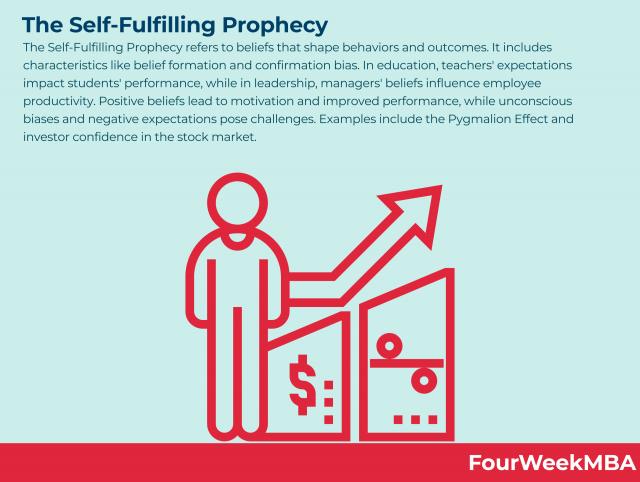The Self-Fulfilling Prophecy refers to Beliefs that shape behaviors and outcomes. It includes characteristics like belief formation and confirmation bias. In education, teachers’ expectations impact students’ performance, while in leadership, managers’ beliefs influence employee productivity. Positive beliefs lead to motivation and improved performance, while unconscious biases and negative expectations pose challenges. Examples include the Pygmalion Effect and investor confidence in the stock market.
Characteristics:
- Belief Formation: At the core of the self-fulfilling prophecy is the formation of beliefs. These beliefs can be conscious or subconscious, positive or negative, and they often stem from prior experiences, societal influences, or personal biases.
- Confirmation Bias: A critical aspect of the self-fulfilling prophecy is the presence of confirmation bias. This cognitive bias refers to the human tendency to seek out and interpret information or evidence in a way that confirms our existing beliefs. It reinforces the feedback loop between beliefs and actions.
- Feedback Loop: The self-fulfilling prophecy operates as a feedback loop. Beliefs shape our actions and behaviors, which, in turn, lead to outcomes that align with those beliefs. These outcomes, in a cyclical manner, reinforce and strengthen the original beliefs.
Use Cases:
The self-fulfilling prophecy finds application in various domains where beliefs play a pivotal role:
- Education: In the realm of education, teachers’ expectations of their students can significantly influence student performance. When educators hold high expectations for their students, these students tend to excel, fulfilling the positive prophecy. Conversely, low expectations can lead to underperformance, perpetuating a negative cycle.
- Leadership: The beliefs and expectations of managers and leaders can profoundly impact employee productivity and performance. When leaders have confidence in their team members’ abilities and communicate high expectations, employees often rise to meet those expectations, resulting in improved performance.
- Economics: Investor confidence and market behavior are strongly intertwined. Positive beliefs about the economy and investment opportunities can boost investor confidence, leading to increased investments and potentially driving economic growth. Conversely, widespread pessimism can trigger market downturns.
Benefits:
The self-fulfilling prophecy offers several advantages:
- Motivation: Positive beliefs and expectations can serve as powerful motivators. When individuals believe in their abilities and anticipate success, they are more likely to exert effort and persist in their endeavors.
- Performance Enhancement: The self-fulfilling prophecy can lead to improved performance. When individuals are guided by positive beliefs and expectations, they often strive for excellence and achieve better results.
- Social Impact: On a larger scale, the self-fulfilling prophecy can drive positive change in groups, communities, or societies. When collective beliefs are aligned with constructive goals and expectations, they can lead to improved outcomes and social progress.
Challenges:
However, the self-fulfilling prophecy is not without its challenges:
- Bias: Unconscious biases can heavily influence beliefs, leading to unintentional reinforcement of stereotypes or prejudices. These biases can perpetuate negative outcomes for marginalized or stereotyped groups.
- Ethical Concerns: There are ethical concerns associated with intentionally manipulating beliefs to achieve specific outcomes. Deliberate attempts to create self-fulfilling prophecies, especially if they involve deception or harm, raise ethical questions.
- Negative Impact: Just as positive beliefs can lead to positive outcomes, negative beliefs can have adverse effects. Individuals burdened by negative expectations may become demotivated, leading to a self-fulfilling prophecy of failure.
Examples:
To illustrate the self-fulfilling prophecy in action, consider the following real-life examples:
- Pygmalion Effect: The Pygmalion Effect, a classic example of the self-fulfilling prophecy, demonstrates how high expectations can lead to improved performance. In an educational context, when teachers hold high expectations for certain students, those students tend to excel academically, fulfilling the positive prophecy.
- Stock Market: In the world of finance, investor confidence has a profound impact on stock market trends. When investors collectively believe that the market is on an upward trajectory, their buying behavior can drive stock prices higher, creating a self-fulfilling prophecy of market growth.
- Stereotypes: Stereotypes are a pervasive example of the self-fulfilling prophecy in everyday life. When individuals are subjected to negative stereotypes based on their gender, race, or other characteristics, they may internalize these stereotypes, leading to self-doubt and underperformance, thus confirming the initial stereotype.
Self-Fulfilling Prophecy: Key Highlights
- Definition: The Self-Fulfilling Prophecy refers to beliefs that shape behaviors and outcomes, including characteristics like belief formation and confirmation bias.
- Characteristics:
- Belief Formation: How beliefs influence actions and behaviors.
- Confirmation Bias: Tendency to seek evidence confirming existing beliefs.
- Feedback Loop: Beliefs shaping actions, resulting in expected outcomes.
- Use Cases:
- Education: Teachers’ expectations impacting student performance.
- Leadership: Managers’ beliefs influencing employee productivity.
- Economics: Investor confidence affecting market behavior.
- Benefits:
- Motivation: Positive beliefs leading to increased motivation.
- Performance Enhancement: Improved performance due to positive expectations.
- Social Impact: Creating positive change in groups or communities.
- Challenges:
- Bias: Unconscious biases influencing beliefs.
- Ethical Concerns: Potential ethical implications of manipulating beliefs.
- Negative Impact: Adverse effects of negative expectations.
- Examples:
- Pygmalion Effect: High expectations leading to improved performance.
- Stock Market: Investor confidence impacting market trends.
- Stereotypes: Stereotypes influencing individual behavior.
Connected Thinking Frameworks
Convergent vs. Divergent Thinking
Critical Thinking
Biases
Second-Order Thinking
Lateral Thinking
Bounded Rationality
Dunning-Kruger Effect
Occam’s Razor
Lindy Effect
Antifragility
Systems Thinking
Vertical Thinking
Maslow’s Hammer
Peter Principle
Straw Man Fallacy
Streisand Effect
Heuristic
Recognition Heuristic

